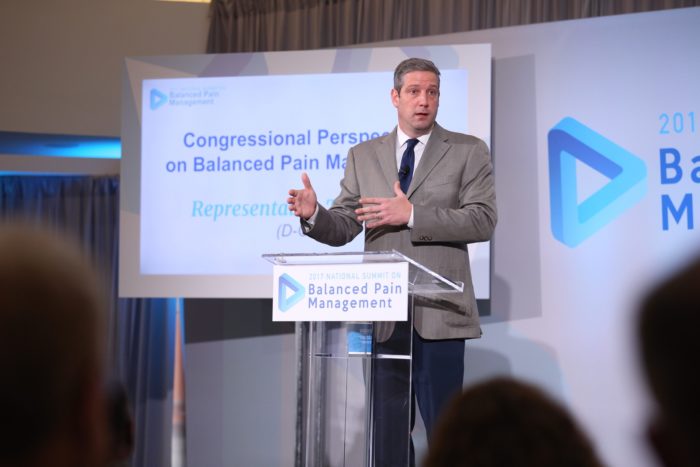Summit on Balanced Pain Management Underscores Need for Access, Coverage
November 17, 2017
“I didn’t like feeling like a victim. I liked feeling like a warrior.” So explained Ally Hilfiger – artist, author and daughter of fashion mogul Tommy Hilfiger – who told her story of overcoming Lyme disease at the annual National Summit on Balanced Pain Management. The summit featured U.S. Representative Tim Ryan (D-Ohio) as well as members of the regulatory community, nonprofits, industry, and patient groups to explore the value of a multi-prong approach to pain treatment.
Hilfiger described the intense pain brought on by Lyme disease, which doctors didn’t diagnose until years after she contracted the disease. “Putting lotion on my legs felt like I was getting beaten by a baseball bat,” Hilfiger recollected. Before finally getting treatment, Hilfiger lost the ability to drive and, for a period of time, even the ability to read. She recounted her story to Paul Christo, MD, host of Sirius XM’s “Aches and Gains.”

Stigma was also a factor. Dark sunglasses would have protected her eyes from extreme sensitivity, Hilfiger explained, but joked, “I couldn’t wear them inside, because there’s already the stereotype that I’m a bitch.” Hilfiger recounted other people’s perception that she “looked fine” even while she experienced intense pain.
A panel discussion on migraine echoed these sentiments. Jan Brandes, MD, described how migraine patients, particularly women, are often stigmatized. “Society blames the patients, and the patients blame themselves,” Dr. Brandes explained. Jamie Sanders, a blogger at The Migraine Diva, described how the burden of proof falls on the patient to prove that her pain is “real.” Meanwhile, Penney Cowan of the American Chronic Pain Association described the need for patients to take charge of their treatment. “Patients are always looking to their health care providers for relief,” she noted, “but they need to learn to manage themselves.”
For Americans in pain, finding the relief they need isn’t easy. Brian Kennedy, executive director of the Alliance for Patient Access, explained in his opening remarks that balanced pain management offers “two-fold” benefits: it can impact the level of prescription drug abuse and addiction while also allowing for optimal patient care.
But coverage issues impact patients’ ability to receive multidisciplinary pain care. As several speakers noted, health plan coverage may favor less expensive pharmacologic treatment over multi-prong care that includes non-pharmacologic treatments such as chiropractic care and acupuncture. As Stephen Ziegler, Ph.D., of Purdue University, summarized, “Denial of coverage is denial of treatment.”
Dr. Ziegler also detailed the unintended consequences of shortsighted policy responses to the nation’s opioid crisis. “No one evaluates policies or laws to see if they’re effective or if they have unintended consequences,” Dr. Ziegler noted.
And there are many such patients. Wendy Weber, N.D., Ph.D., of the National Institutes of Health National Center for Complementary and Integrative Health reported that chronic pain affects 100 million adults and costs the nation $500 billion annually in health care costs and lost productivity. She explained the need for large-scale clinical trials to determine which non-pharmacological therapies are most effective and how to best deliver those interventions.
Eric Schoomaker, MD, PhD described the need to change the culture of pain management in the military. “Why is alternative medicine is ‘the alternative?’” Dr. Schoomaker asked, “Why isn’t it the primary?”
Friedhelm Sandbrink, MD, of the Veterans Affairs Medical Center echoed the importance of interdisciplinary pain care for veterans. He noted that in 2012, more than 2 million veterans experienced chronic pain. One-third of those took prescription opioids to treat their pain. He emphasized the department’s clinical practice guidelines, which discourage across-the-board cutting and encourage slow tapering for patients who need to switch treatments.
Summit participants also explored the role of abuse-deterrent opioid formulations in addressing the nation’s opioid epidemic. The technology, which makes pills difficult to crush or dissolve for recreational use, allows patients to receive necessary treatment for pain while simultaneously helping to address misuse. Health plans have balked at the drugs’ cost, however.
Ash Diwan, MD, explained that immediate release opioids have played into the opioid crisis by presenting a cheap option that could result in misuse or addiction. He emphasized the need to move toward long-acting, slow release medications to deter abuse. Economist Wayne Winegarden, PhD,commented that the policy environment is tilting toward opioid abuse and “forgetting pain.” Steven Passik, PhD, of Collegium Pharmaceuticals pointed to America’s perpetual addiction problems. “We as a society have a massive problem of addiction in this country, whether it be to food, alcohol, or opioids.”
The Food and Drug Administration’s Douglas Throckmorton, MD, emphasized that abuse-deterrent opioids and other technologies designed to target misuse are “very important for the agency.” The FDA is offering acceleration tools such as fast tracking and priority review to get such developments approved.
Representative Tim Ryan (D-Ohio) addressed summit attendees about the role of lifestyle choices, particularly diet, in disease and pain. He pointed out the siloed approach to policymaking and the need for holistic solutions that address the big picture. “Not solutions that are left or right,” Rep. Ryan explained, “but solutions that are working out in the field.”

Rep. Ryan also emphasized the role of market forces in making more options for pain treatment available. Reimbursement for providers of alternative treatments such as acupuncture or mindfulness-based stress reduction would increase the number of professionals who offer these services, Rep. Ryan explained, as well as the number of patients who can receive them. Rep. Ryan created the Quiet Time Caucus on Capitol Hill and hosts weekly meditation sessions for congressional staff.
Throughout the day-long program, consensus formed around several themes: the need for more options for treating pain, and the necessity for better coverage policies to make that access available. As the FDA’s Douglas Throckmorton, MD, characterized America’s conundrum with pain and addiction, “We know what to do, but we’re not doing it.”
To learn more about balanced pain management, visit www.AllianceBPM.org
Tags: Integrated Care, PainCategorized in: Blog

